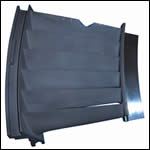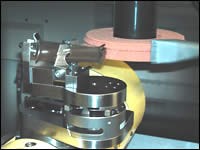Creep-feed Grinding Is A Milling Process
Because creep-feed grinding is essentially a milling process, why not use a VMC? A grinding machine supplier describes how a VMC platform can make creep-feed grinding more effective.
Share




Creep-feed grinding is an abrasive machining process, but beyond that, it doesn’t resemble other forms of grinding. Nelson Beaulieu, grinding product manager with Hardinge Inc., says it makes more sense to characterize creep-feed grinding as a milling process.
After all, creep-feed grinding employs a deep cut and a high metal removal rate, and it features a low feed rate in place of fast reciprocating motion. The “tool” in creep-feed grinding—the grinding wheel—gets buried in the material like a milling cutter.
In fact, that tool gets more effective as its diameter shrinks down closer to the dimensions of the largest milling cutter on a typical machining center. And if the machine itself is designed like a vertical machining center, he says, then a tool such as this becomes more practical.
Mr. Beaulieu says these points summarize the thinking behind his company’s VMC-based grinder. The FGC 2 “flexible grinding center” from Bridgeport (a Hardinge company) represents a departure from traditional creep-feed grinder designs—and the orientation of the spindle is perhaps the most fundamental difference.
Up Out Of The Way
When creep-feed grinding was first developed, Mr. Beaulieu says, practically all grinding machines had horizontal spindles. Creep-feed grinding naturally built on this platform. However, one of the basic requirements of this horizontal design is a big wheel. The wheel diameter has to be large enough for the edge of the wheel to clear the spindle housing and reach the table.
This requirement imposes limitations, he says. Coolant penetration is essential to effective creep-feed grinding, but the wide arc of the big wheel results in a tighter space for this coolant to try to reach. In addition, the big wheel makes it impractical to interpolate along complex machining paths. Instead, parts are often held on complex fixtures, and the part may be moved from fixture to fixture on one creep-feed machine after another as different features of the part are ground.
By contrast, lifting the spindle housing out of the way of the work zone makes it easy to apply a smaller wheel. Coolant can thus be delivered to the cut more effectively, and the part can be fed through rotary axes to let the small-diameter wheel use tool paths like those of a five-axis machining center.
The FGC machine essentially is a five-axis machining center. However, because the work is grinding instead of milling (milling in the conventional sense, that is), the machine had to deliver the sort of stiffness that is a key strength of the traditional horizontal platform. Unlike a typical VMC, the rigid cast iron base of this machine weighs 30,100 pounds. Also unlike a VMC, the machine is used in conjunction with a special coolant system able to deliver the 1,000 psi or 50 gallons per minute that creep-feed grinding requires.
These changes mean the vertical machine is not necessarily less expensive initially. Mr. Beaulieu says the savings come once the machine is applied. Sources of savings include:
- Fewer fixtures or fewer machines. Instead of multiple setups, it may be that all of the grinding can be performed in one setup.
- Reduced setup time, because the need for complex fixturing can be eliminated.
- Fewer machining operations, because the ability to reorient the part within the cycle can make it possible to machine separate features with the same wheel.
- Faster machining (over and above the setup time savings), because the smaller wheel can be moved more nimbly. Mr. Beaulieu says the user can take a lighter depth of cut on this machine and still achieve a higher metal removal rate because the potential feed rate is that much higher.
Conventional Machining
Further savings come when the machine is used exactly as a conventional VMC. Its spindle uses a machining center’s standard BT interface for the tooling, and grinding wheels are delivered to the spindle via a standard machining center toolchanger. The same system can therefore be used to apply more typical machining center tooling within the same cycle. That is, mills or drills can wait in the tool magazine alongside the wheels. If some milled or drilled feature needs to locate with respect to a ground surface, then it makes sense to let the machine produce those additional features while the part is still set up.
One other way the VMC platform makes creep-feed grinding easier to apply relates to resources outside the work zone. With the machine so similar to a standard machining center, it becomes possible for machining center personnel to program and run the creep-feed process effectively. The pool of available talent therefore increases. As Mr. Beaulieu points out, “There are a lot more milling operators out there than there are grinding operators.”
Related Content
Arch Cutting Tools Acquires Custom Carbide Cutter Inc.
The acquisition adds Custom Carbide Cutter’s experience with specialty carbide micro tools and high-performance burrs to Arch Cutting Tool’s portfolio.
Read More5 Tips for Running a Profitable Aerospace Shop
Aerospace machining is a demanding and competitive sector of manufacturing, but this shop demonstrates five ways to find aerospace success.
Read MoreBroaching Tool Technology For Lathes Used to Slot Inconel Parts
This shop finds value in using an indexable-insert-style broaching tool to create blind-hole slots in heat-treated Inconel aerospace parts on a CNC lathe.
Read MoreIncreasing OEM Visibility to Shopfloor Operations for the Win
A former employee of General Motors and Tesla talks about the issues that led to shutdowns on factory lines, and what small- to medium-sized manufacturers can do today to win business from large OEMs.
Read MoreRead Next
Building Out a Foundation for Student Machinists
Autodesk and Haas have teamed up to produce an introductory course for students that covers the basics of CAD, CAM and CNC while providing them with a portfolio part.
Read MoreSetting Up the Building Blocks for a Digital Factory
Woodward Inc. spent over a year developing an API to connect machines to its digital factory. Caron Engineering’s MiConnect has cut most of this process while also granting the shop greater access to machine information.
Read MoreRegistration Now Open for the Precision Machining Technology Show (PMTS) 2025
The precision machining industry’s premier event returns to Cleveland, OH, April 1-3.
Read More


































.jpg;maxWidth=970;quality=90)